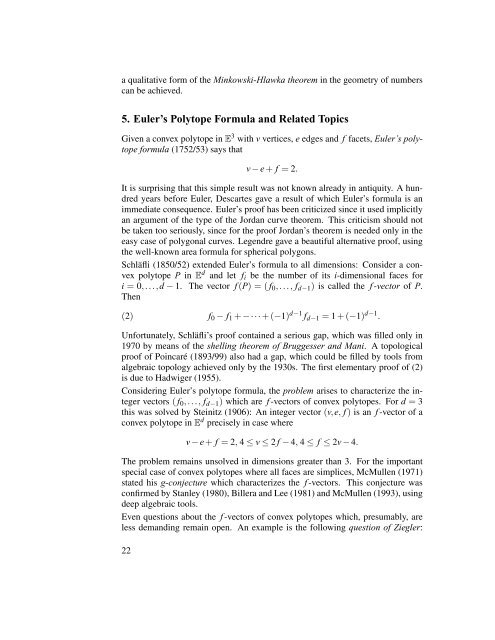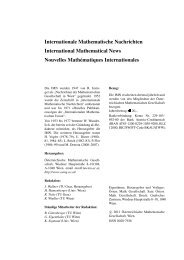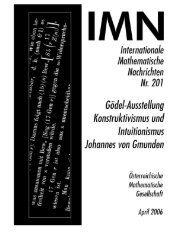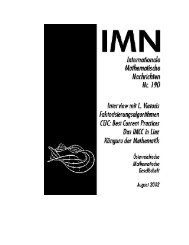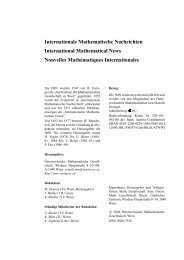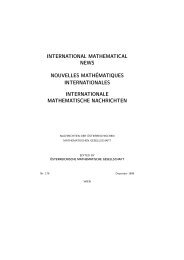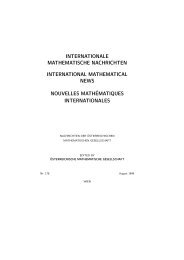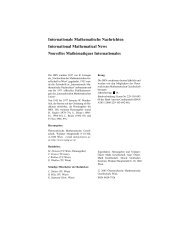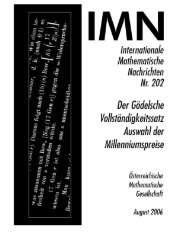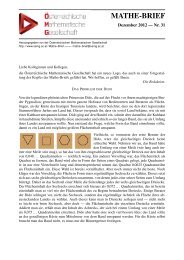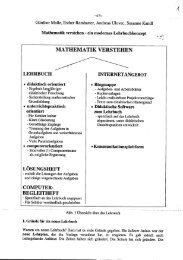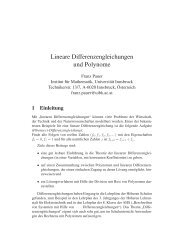199 - Ãsterreichische Mathematische Gesellschaft
199 - Ãsterreichische Mathematische Gesellschaft
199 - Ãsterreichische Mathematische Gesellschaft
Erfolgreiche ePaper selbst erstellen
Machen Sie aus Ihren PDF Publikationen ein blätterbares Flipbook mit unserer einzigartigen Google optimierten e-Paper Software.
a qualitative form of the Minkowski-Hlawka theorem in the geometry of numbers<br />
can be achieved.<br />
5. Euler’s Polytope Formula and Related Topics<br />
Given a convex polytope in E 3 with v vertices, e edges and f facets, Euler’s polytope<br />
formula (1752/53) says that<br />
v − e + f = 2.<br />
It is surprising that this simple result was not known already in antiquity. A hundred<br />
years before Euler, Descartes gave a result of which Euler’s formula is an<br />
immediate consequence. Euler’s proof has been criticized since it used implicitly<br />
an argument of the type of the Jordan curve theorem. This criticism should not<br />
be taken too seriously, since for the proof Jordan’s theorem is needed only in the<br />
easy case of polygonal curves. Legendre gave a beautiful alternative proof, using<br />
the well-known area formula for spherical polygons.<br />
Schläfli (1850/52) extended Euler’s formula to all dimensions: Consider a convex<br />
polytope P in E d and let f i be the number of its i-dimensional faces for<br />
i = 0,...,d − 1. The vector f (P) = ( f 0 ,..., f d−1 ) is called the f -vector of P.<br />
Then<br />
(2) f 0 − f 1 + −··· + (−1) d−1 f d−1 = 1 + (−1) d−1 .<br />
Unfortunately, Schläfli’s proof contained a serious gap, which was filled only in<br />
1970 by means of the shelling theorem of Bruggesser and Mani. A topological<br />
proof of Poincaré (1893/99) also had a gap, which could be filled by tools from<br />
algebraic topology achieved only by the 1930s. The first elementary proof of (2)<br />
is due to Hadwiger (1955).<br />
Considering Euler’s polytope formula, the problem arises to characterize the integer<br />
vectors ( f 0 ,..., f d−1 ) which are f -vectors of convex polytopes. For d = 3<br />
this was solved by Steinitz (1906): An integer vector (v,e, f ) is an f -vector of a<br />
convex polytope in E d precisely in case where<br />
v − e + f = 2, 4 ≤ v ≤ 2 f − 4, 4 ≤ f ≤ 2v − 4.<br />
The problem remains unsolved in dimensions greater than 3. For the important<br />
special case of convex polytopes where all faces are simplices, McMullen (1971)<br />
stated his g-conjecture which characterizes the f -vectors. This conjecture was<br />
confirmed by Stanley (1980), Billera and Lee (1981) and McMullen (<strong>199</strong>3), using<br />
deep algebraic tools.<br />
Even questions about the f -vectors of convex polytopes which, presumably, are<br />
less demanding remain open. An example is the following question of Ziegler:<br />
22


